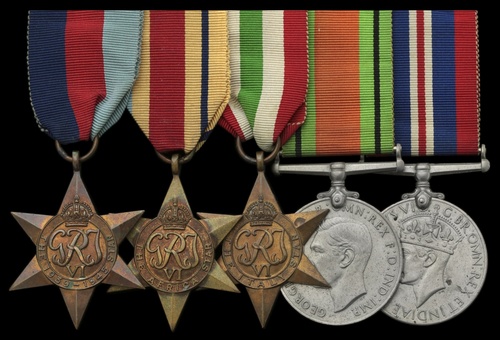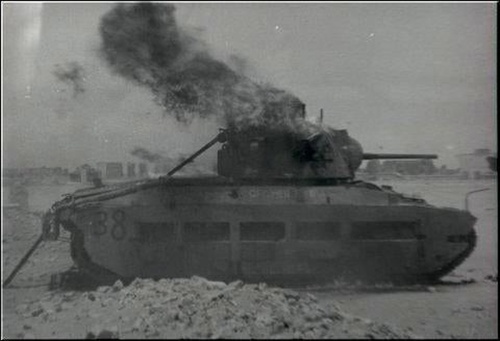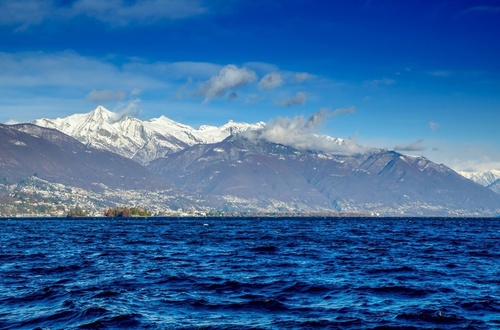Auction: 22003 - Orders, Decorations and Medals
Lot: 332
A rare and documented Second World War escaper's campaign group of five awarded to Trooper E. W. Farrier, 7th Royal Tank Regiment, Royal Armoured Corps (R.A.C.)
Having been taken prisoner in the ferocious tank engagements of Operation "Battleaxe" in June 1941 - when his Matilda II was knocked-out by 88mm. fire - he exited the Italian P.O.W. camp PG 106/22 at Busonengo in September 1943, sought refuge at an Italian farm and then successfully crossed the Italian-Swiss Alps three months later
It was a notable achievement: out of the almost 200,000 British and Commonwealth servicemen captured by the Germans and Italians during the Second World War, just 1,200 or so managed to make a 'home run'
1939-45 Star; Africa Star; Italy Star; Defence and War Medals 1939-45, together with his wartime 'RTR' cloth shoulder flash, good very fine (6)
Edward William Farrier was born in London on 29 May 1919 and was working as a porter at Hammersmith on the outbreak of hostilities. He subsequently enlisted at Farnborough in November 1939 and was posted as a Trooper to the Royal Armoured Corps (R.A.C.).
Operation "Battleaxe"
Embarked for North Africa as a member of 7th Royal Tank Regiment, a component of 4th Armoured Brigade, he quickly saw action in Operation "Battleaxe" in mid-June 1941, the ill-fated attempt to raise the siege of Tobruk.
Farrier and his comrades fought valiant close-range actions over three days, not least in the defence of Fort Capuzzo, but their Matilda II tanks proved vulnerable to enemy 88mm fire. In fact, 4th Armoured Brigade had a total of 220 tanks knocked-out during "Battleaxe" and among them was Farrier's Matilda, a victim of just such fire.
Likely wounded, he was taken prisoner on 17 June 1941.
Prigioni de Guerra - home run
The remainder of his story is documented in his secret I.S. 9 debrief, as related to an Intelligence Officer in Switzerland in December 1943, following his successful bid for freedom (TNA WO 208/4250, refers).
In the interim, he had been incarcerated at a variety of locations, including Bardia, Benghazi and Brindisi, and thence at PG 59 at Servigliano, PG 53 at Macerata and finally PG 106/22 at Busonengo.
Given future events, his time at PG 59 is not without interest, for a fellow prisoner there was 886511 Gunner Albert Hollings, R.H.A., a noted tunneller who would later assist Farrier in his home run to Switzerland.
And the catalyst for that bid for freedom occurred at the time of the Italian armistice in September 1943, when Farrier exited PG 59 and sought refuge at a farmhouse owned by Stella Pietro, located in the hamlet of Villa Boit in Vercilli, Piedmont. Undoubtedly a gallant soul - dare one say a 'star' - Stella is duly credited in Farrier's I.S. 9 debrief.
Then on 6 December 1943, Farrier and five fellow escapers departed the farmhouse for Switzerland, crossing the mountains to Forno Tece and thence the Swiss border at Brissago, which lies on the western shore of Lake Maggiore in the district of Locarno.
The success of their challenging enterprise clearly owed much to the aforementioned Gunner Albert Hollings, for he had joined Farrier at the farmhouse and acted as a guide. Hollings was subsequently mentioned in despatches, the recommendation stating:
'After the Armistice the main gate of Camp 106/22 was left open and Hollings walked out on 10 September 1943. He went to Villa Boit where he worked on a farm for two months.
Hollings then worked as a guide for an organisation. After successfully leading three parties to Switzerland he was forced to give up guiding as his boots were worn out; he joined the partisans and stayed with them for a short time before leaving for Switzerland. With the aid of guides, Hollings with a party of two officers and eleven other ranks finally crossed the Swiss frontier on 7 February 1944' (TNA WO 373/64/380, refers).
Of Farrier's movements after his arrival in Switzerland little is known but his Soldier's Service and Pay Book notes that he was granted repatriation leave in November-December 1944 and that he transferred to the Royal Army Service Corps as a driver in February 1945.
He was finally released from service as a Lance-Corporal in July 1946.
Postscript
Apart from the prospect of visiting the hamlet of Villa Boit in Vercilli, Piedmont, where Farrier sought refuge at Stella Pietro's farmhouse, it is also possible to visit the site and surviving buildings of PG 59 at Servigliano, where he was onetime incarcerated and likely met Gunner Hollings for the first time:
https://camp59survivors.com/2014/02/04/is9-history-organization/
If so minded, it would be hard to think of a better way of rounding off such a tour than a celebratory drink on the shores of Lake Maggiore at Brissago.
Sold with the following original documentation:
(i)
The recipient's Soldier's Service and Pay Book.
(ii)
A letter from the Royal Tank Regiment's P.O.W. War Fund to the recipient's mother, dated 14 September 1944, noting her son's escape to Switzerland but regretting that she could not send him any parcels.
(iii)
An Italian National Fascist Party membership card, presumably a 'souvenir' of Farrier's travels, possibly even a forgery for escape purposes.
(iv)
The recipient's Record of Service Card and Certificate of Transfer to the Army Reserve, both dated 28 March 1946, together with Railway Ticket for his return to London.
(v)
A wartime group photograph of soldiers, circa 1940, who appear to be wearing R.A.C. cap badges, and likely including the recipient.
Subject to 20% VAT on Buyer’s Premium. For more information please view Terms and Conditions for Buyers.
Sold for
£450
Starting price
£220











